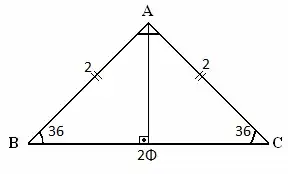Assume that we have been asked to find the value of $\sin (18^\circ)$. We know that there are many ways to find it out. However, I'll be going with golden ratio! Let's draw a triangle whose apical angle is $36^{\circ}$. Note that this is an isosceles triangle, otherwise we couldn't apply it.
Consider $|BC| = 2$, from property of height, we have that $|BD| = 1$ and $|DC| = 1$. Hence I got a right triangle whose one angle is $18^{\circ}$. Now I almost found it.
$$\sin (18^{\circ}) = \dfrac{1}{2\varphi} = \dfrac{1}{\sqrt 5 + 1} = \dfrac{\sqrt 5 - 1}{4} $$
where $\varphi = \dfrac{1+\sqrt 5}{2}$.
Now consider we have been asked to find the value of $\cos (36^{\circ})$. Here I have to draw a triangle whose base angles are $36^{\circ}$.
From the triangle, we have that
$$\cos 36^{\circ} = \dfrac{\varphi}{2} = \dfrac{1+ \sqrt 5}{4}$$
Then what about $\sin (28^{\circ})$? I mean can we apply it for other trigonometric values?
Regards!

